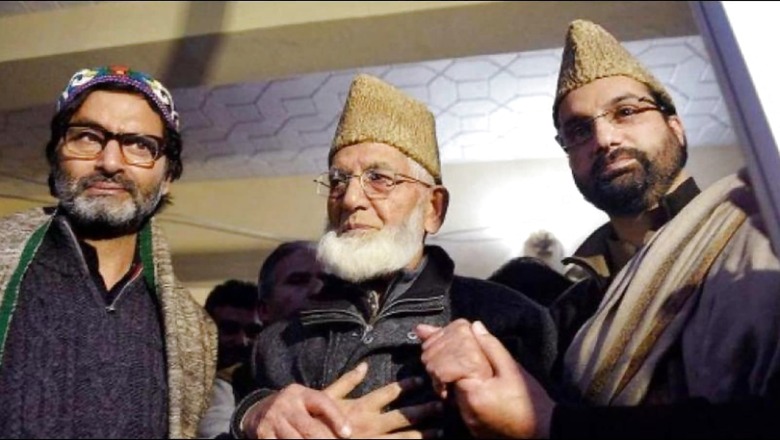
views
The Centre is likely to impose a ban under the stringent Unlawful Activities (Prevention) Act on both factions of the Hurriyat Conference, which has been spearheading the separatist movement in Jammu and Kashmir for over two decades. A recent probe into the granting of MBBS seats to Kashmiri students by institutions in Pakistan indicates that the money collected from aspirants by some organisations, which were part of the Hurriyat Conference conglomerate, was being used for funding terror organisations in the Union territory. Both the factions of the Hurriyat are likely to be banned under Section 3(1) of the Unlawful Activities (Prevention) Act, or the UAPA, under which “if the Central Government is of opinion that any association is, or has become, an unlawful association, it may, by notification in the Official Gazette, declare such association to be unlawful.”
Here is how the movement started and why it lost ground:
How was the Hurriyat born?
The All Parties Hurriyat Conference (APHC) was formed on July 31, 1993, as a political platform of the separatist movement. It was an extension of the conglomerate of parties that had come together to contest Assembly polls against a National Conference-Congress alliance in 1987 — an election that was widely alleged to have been rigged. The conglomerate of disparate ideologies was held together by their common position that Jammu & Kashmir was “under occupation of India”, and the collective demand that “the wishes and aspirations of the people of the state should be ascertained for a final resolution of the dispute”.
At a time when militancy was at its peak, this conglomerate represented the political face of the militant movement, and claimed to “represent the wishes and aspirations of the people”. It had brought together two separate, but strong ideologies: those who sought J&K’s independence from both India and Pakistan, and those who wanted J&K to become part of Pakistan. Most of the groups that were part of the Hurriyat had their militant wings, or were linked to a militant outfit.
Who formed the organisation?
On December 27, 1992, the 19-year-old Mirwaiz Umar Farooq, who had taken over as chairman of J&K Awami Action Committee (J&KAAC) and become the head priest of Kashmir after the assassination of his father Mirwaiz Farooq, called a meeting of religious, social and political organisations at Mirwaiz Manzil. The aim of this meeting was to lay the foundation of a broad alliance of parties that were opposed to “Indian rule” in J&K. Seven months later, the APHC was born, with Mirwaiz Umar Farooq as its first chairman.
The APHC executive council had seven members from seven executive parties: Syed Ali Shah Geelani of Jamat-e-Islami, Mirwaiz Umar Farooq of Awami Action Committee, Sheikh Abdul Aziz of People’s League, Moulvi Abbas Ansari of Ittehad-ul-Muslimeen, Prof Abdul Gani Bhat of Muslim Conference, Yasin Malik of JKLF, and Abdul Gani Lone of People’s Conference.
What happened after abolition of article 370?
for the last two years, following the abrogation of Jammu and Kashmir’s special status on August 5, 2019 and the downgrade of the state into two UTs, the Hurriyat leadership has been silent, except for two “policy statements” calling for a dialogue to resolve the Kashmir dispute.
Mirwaiz Umar Farooq, who heads the moderate faction, is under house detention for over two years now. Most of the first and second-rung leaders of the hardline faction are behind bars. Among the Hurriyat leaders in jail are Shabir Ahmad Shah, Nayeem Khan, Masrat Alam, Ayaz Akbar, Peer Saifullah and Shahidul Islam. JKLF chief Yasin Malik is also behind bars.
But why the ban?
According to sources in the government, a recent probe into the granting of MBBS seats to Kashmiri students by institutions in Pakistan indicates that the money collected from aspirants by some organisations, which were part of the Hurriyat Conference conglomerate, was being used for funding terror organisations in the Union territory.
Both the factions of the Hurriyat are likely to be banned under Section 3(1) of the Unlawful Activities (Prevention) Act, or the UAPA, under which “if the Central Government is of opinion that any association is, or has become, an unlawful association, it may, by notification in the Official Gazette, declare such association to be unlawful.”
The separatist conglomerate broke into two factions in 2005 with the moderate group being led by the Mirwaiz and the hardline faction headed by Syed Ali Shah Geelani.
So far, the Centre has banned the Jamaat-e-Islami and the JKLF under the UAPA. The ban was imposed in 2019.
Read all the Latest News, Breaking News and Assembly Elections Live Updates here.


















Comments
0 comment